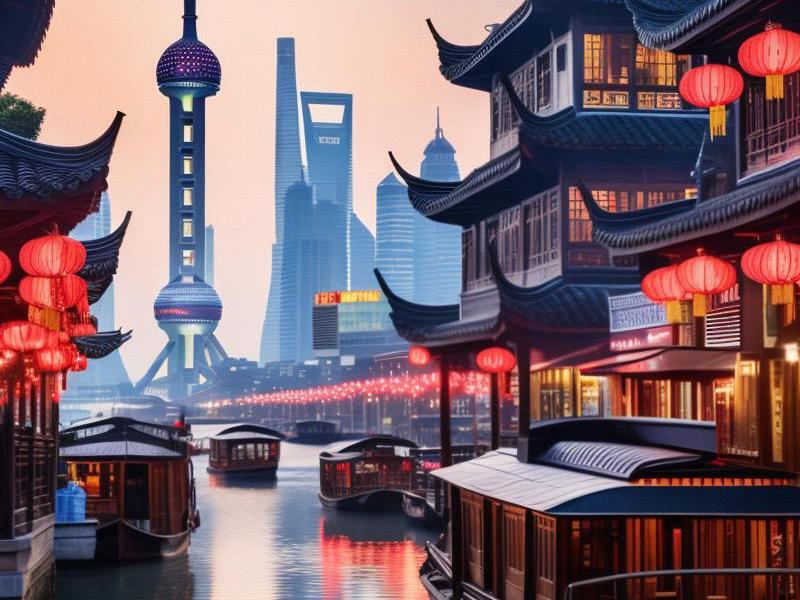Shanghai Chronicles: A Journey Through the Heart of Modern China
⏱ 2025-05-02 00:57 🔖 爱上海千花网
📢0℃

Shanghai, often referred to as the "Pearl of the Orient," stands as a beacon of China's economic and cultural prowess. Over the past century, this city has undergone a remarkable transformation, evolving from a humble fishing village into one of the world's most dynamic and influential cities. Its skyline, a blend of historic architecture and cutting-edge skyscrapers, is a testament to its rich history and rapid modernization.
The journey of Shanghai began in the 19th century when it was forcibly opened to foreign trade following the First Opium War. The establishment of the International Settlement and the French Concession brought an influx of Western culture, architecture, and technology. This period laid the foundation for Shanghai's cosmopolitan character, with its iconic Bund, a waterfront promenade lined with colonial-era buildings, serving as a vivid reminder of its colonial past.
As the 20th century unfolded, Shanghai became the financial and cultural hub of China. The city was a center of commerce, hosting major banks, trading companies, and media outlets. It was also a cradle of Chinese cinema, literature, and art, giving rise to movements such as the New Culture Movement and the May Fourth Movement. However, the city's prosperity was interrupted by the Second Sino-Japanese War and the subsequent Chinese Civil War, which saw Shanghai fall under communist control in 1949.
The latter half of the 20th century marked a new chapter for Shanghai. Under the leadership of the Communist Party of China, the city underwent significant changes. The Maoist era saw Shanghai focusing on heavy industry, but it wasn't until the late 1970s with the beginning of China's reform and opening-up policy that Shanghai truly began to thrive again. The establishment of the Pudong New Area in 1990 was a pivotal moment, signifying the city's resurgence on the global stage.
新夜上海论坛
Pudong, once a rural area across the Huangpu River from the historic city center, has been transformed into a modern financial district. The iconic Oriental Pearl Tower, the Jin Mao Tower, and the Shanghai World Financial Center are just a few of the skyscrapers that have reshaped the city's skyline. Pudong's Lujiazui area is home to the Shanghai Stock Exchange and numerous multinational corporations, making it a symbol of China's economic reform and opening-up.
Shanghai's economic growth has been nothing short of spectacular. It is now one of the world's largest cities by population and a leading global financial center. The city's port, the Port of Shanghai, is the busiest container port in the world, handling millions of containers annually. This maritime hub underscores Shanghai's importance in global trade and commerce.
Culturally, Shanghai remains a vibrant city that celebrates its heritage while embracing modernity. The city is home to a diverse range of cultural institutions, including museums, theaters, and art galleries. The Shanghai Museum, with its impressive collection of Chinese art, and the Shanghai Grand Theatre, which hosts a variety of performances, are just two examples of the city's cultural offerings.
上海龙凤千花1314
The Bund and the Old City are places where history and modernity coexist. The Bund showcases the city's colonial past with its historic buildings, while the Old City, or Yuyuan Bazaar, offers a glimpse into traditional Chinese architecture and culture. The Yu Garden, a classical Chinese garden, is another site that reflects Shanghai's rich cultural heritage.
Shanghai's culinary scene is another aspect that reflects its unique blend of cultures. From traditional Shanghainese cuisine, known for its sweet and savory flavors, to international dishes, the city offers a gastronomic experience that caters to all tastes. The bustling night markets and food streets provide an authentic taste of the city's vibrant food culture.
The city's rapid development has not been without challenges. Issues such as urban sprawl, environmental concerns, and social inequality have emerged as the city continues to grow. However, Shanghai has taken steps to address these issues through sustainable urban planning and investment in green technologies.
上海龙凤419是哪里的
Shanghai's global influence extends beyond its economic and cultural achievements. It has become a hub for international diplomacy, hosting major global events such as the World Expo in 2010. The Expo showcased China's commitment to innovation and sustainable development, leaving a lasting legacy on the city and the world.
As Shanghai looks to the future, it aims to maintain its position as a leading global city. The city's government has outlined plans for further development, including the expansion of its transportation network, the promotion of innovation and technology, and the enhancement of its quality of life.
In conclusion, Shanghai's story is one of resilience, transformation, and ambition. It is a city that has embraced change while preserving its rich cultural heritage. As it continues to evolve, Shanghai remains a vital part of China's narrative and a symbol of the country's rise on the global stage. The journey through Shanghai's chronicles offers a fascinating insight into the heart of modern China, a city that is as dynamic as the nation it represents.
Shanghai Style Revolution: How Local Women Are Crafting a New Global Beauty Paradigm《边界消融时:上海与周边城市的"同城化"实验》Shanghai Showgirls: Entertaining Life on the Edge of CultureShanghai and the Surrounding Area: A Dynamic Hub of Economic and Cultural ExchangeShanghai's Nightlife Evolution: The New Era of Entertainment Clubs in China's Global CitySilicon Bund: Shanghai's Ambitious Quest to Become Asia's Tech Capital《共饮一江水:长三角生态绿色一体化发展示范区三年记》Shanghai's Nightlife Evolution: How Entertainment Venues Are Redefining Urban Leisure in 2025Shanghai's Neuro-Aesthetic Singularity: Where Jiangnan Silk Algorithms Rewrite Quantum GlamourNeon Renaissance: How Shanghai's Elite Clubs Are Redefining China's Nightlife Economy

